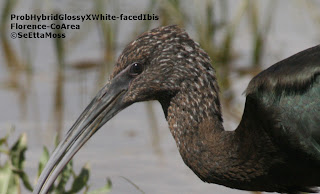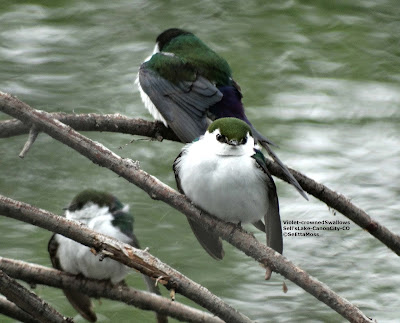Probable Glossy Ibis near Florence,CO-now prob hybrid GlossyXWhite-facedIbis
Having just read a big discussion about identifying Glossy Ibis in non-breeding plumage (actually the facial skin is the issue most discussed) as the field marks are substantially less obvious in field after breeding season. Both of these pics are of the same bird, top just further enlarging it to show more detail. I photographed this along with several other Plegadis ibis in a flooded field near Florence, CO earlier this week. As can be seen in both pics this bird has a dark brown iris which though a field mark for Glossy Ibis is also seen in juvenile White-faced Ibis. (Birds of North AmericaBNA online states, "immature White-faced until at least first winter has gray-brown iris") However, this bird appears to be an adult in Basic plumage per BNA and article on Plegadis ibis published in Sora by Patten and Lasley which states, "It is straightforward to distinguish between a Plegadiis in Juvenal plumage and one in basic plumage. A. uniform muddy-brown head and neck lacking white streaking and the dull brown underparts characterize Juvena plumage(Kaufman1990). Juveniles exibit a variable amount of white splotching on the throat. . . ."
Also apparent in both pics is that this bird has pale bluish/grayish facial skin which is consistent with Glossy Ibis in winter per BNA which further clarifies winter plumage identification as follows: "Facial skin on White-faced Ibis becomes dull grayish-pink during nonbreeding season. Pale blue-gray skin bordering facial skin o
n Glossy Ibis may be confused with white feathering of White-faced, but note blue-gray lines of Glossy do not extend behind eye." (found in 'Distinguishing Characteristics section). More pics and discussion coming in next post. SeEtta (Note: to reduce issues for id, only editing was cropping to enlarge ibis pics , no color corrections or lighting changes,etc--just hard daylight at 1:30 pm on sunny day) Post note: H. Douglas Pratt has reviewed photos and says he believes it is probably a hybrid GlossyXWhite-facied. Dr. Pratt, who is the Research Curator of Birds at North Carolina Museum of Natural Sciences and who has who provided species accounts of both of these in the The Audubon Society master guide to birding, is a respected contributor to Bird Id Frontiers. In his email to me Dr Pratt said he was traveling and would send me his detailed analysis when he returns home next week. I will ask his permission to share his remarks.
**Email comments from Dr. Pratt:
Dear SeEtta:
The bird in your photo looks good for a Glossy Ibis except for one thing, the color of the facial skin borders. These borders should never have any hint of red in them. They would be pale blue or off-white in a 1st-year basic plumage bird, which yours appears to be (no chestnut in shoulders of 1st-year birds). I seem to detect a distinct pinkish cast to the borders, giving them a mauve look that I have seen in other hybrids recently found in Kansas and Colorado. But the color is not intense, and could be an artifact of lighting. My professional opinion is that you have either a Glossy or a hybrid, possibly a backcross that is mostly Glossy.
Note that White-faced Ibises at this stage often show pale borders to their facial skin that are very much like those of Glossies, but they always show some red tinge either in the dark area or most often in the borders themselves, and they should show red eyes by this time.
I hope this is helpful. Feel free to pass these comments on to others.
Doug
H. Douglas Pratt
Ornithologist, illustrator, musician
1205 Selwyn Lane
Cary, NC 27511
Research Curator of Birds, Emeritus
North Carolina Museum of Natural Sciences
11 West Jones Street
Raleigh NC 27601
Website: http://www.hdouglaspratt.com/i
n Glossy Ibis may be confused with white feathering of White-faced, but note blue-gray lines of Glossy do not extend behind eye." (found in 'Distinguishing Characteristics section). More pics and discussion coming in next post. SeEtta (Note: to reduce issues for id, only editing was cropping to enlarge ibis pics , no color corrections or lighting changes,etc--just hard daylight at 1:30 pm on sunny day) Post note: H. Douglas Pratt has reviewed photos and says he believes it is probably a hybrid GlossyXWhite-facied. Dr. Pratt, who is the Research Curator of Birds at North Carolina Museum of Natural Sciences and who has who provided species accounts of both of these in the The Audubon Society master guide to birding, is a respected contributor to Bird Id Frontiers. In his email to me Dr Pratt said he was traveling and would send me his detailed analysis when he returns home next week. I will ask his permission to share his remarks.
**Email comments from Dr. Pratt:
Dear SeEtta:
The bird in your photo looks good for a Glossy Ibis except for one thing, the color of the facial skin borders. These borders should never have any hint of red in them. They would be pale blue or off-white in a 1st-year basic plumage bird, which yours appears to be (no chestnut in shoulders of 1st-year birds). I seem to detect a distinct pinkish cast to the borders, giving them a mauve look that I have seen in other hybrids recently found in Kansas and Colorado. But the color is not intense, and could be an artifact of lighting. My professional opinion is that you have either a Glossy or a hybrid, possibly a backcross that is mostly Glossy.
Note that White-faced Ibises at this stage often show pale borders to their facial skin that are very much like those of Glossies, but they always show some red tinge either in the dark area or most often in the borders themselves, and they should show red eyes by this time.
I hope this is helpful. Feel free to pass these comments on to others.
Doug
H. Douglas Pratt
Ornithologist, illustrator, musician
1205 Selwyn Lane
Cary, NC 27511
Research Curator of Birds, Emeritus
North Carolina Museum of Natural Sciences
11 West Jones Street
Raleigh NC 27601
Website: http://www.hdouglaspratt.com/i




Comments